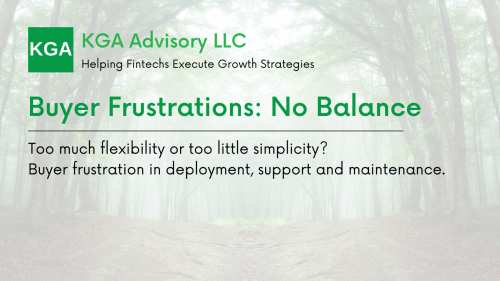
In our last blog, we described that a compelling fintech vendor solution must provide a balance of flexibility and simplicity in a way that meets buyer preferences. Those preferences are driven by things like differing business objectives, skills, timing, and whether there is a legacy system to be replaced.
Lacking the right balance for a market segment, the buyers are frustrated with the complexity of the solution. And, most solutions offer poor balance for large segments of a buyer market (e.g., buyers seeking an “XXX-in-a-Box” solution). If the vendor cannot solve for “-in-a-Box”, that revenue will be lost (which, in many buyer markets, is significant).
Many buyers need more than a few partners from the ecosystem. The frustrations are repeated with and can be compounded by each partner vendor.
Buyers having multiple partners is stacked against buyer partnership functions that are understaffed. In a recent publication by Cornerstone Advisors, almost half of community FI’s with less than $10bn in assets have no FTE’s dedicated to vendor partnerships.
Partner Selection
Vendors often promote having many partners in their ecosystem. However, the partners page is often a simple list. There is little guidance from the vendor about what partners might be the best fit for a buyer.
Further, there are few commercial details in place between the vendor and the members of the ecosystem. The financial services buyer must negotiate pricing, contracts, compliance, and service levels, to name a few, with each ecosystem vendor. Some partner terms may conflict with other partners’ terms.
Integration / Orchestration / Maintenance
Many vendor ecosystem partners are not pre-integrated with the vendor. Integration across vendors is put on the financial services buyer. Further, the vendor usually has a limited understanding of and experience with each partner’s products.
Given those dynamics, it is also up to the financial services buyer to orchestrate among the vendor functions. They must determine function sequencing, dependencies, error conditions, data exchange, and more. And all these challenges must be maintained by the buyer after go-live.
Partner Management / Support / Operation
With a partner ecosystem like those being discussed, the buyer has multiple partner vendors to manage. To some degree, the main vendor has shifted the vendor management burden to the financial services buyer. And, as described above, the buyers’ partner management is poorly staffed.
Usually, the vendor and the ecosystem partners have not designed coordinated buyer support mechanisms. For instance, during a service interruption, coordination among the chosen set of providers is, effectively, put on the buyer.
In our next blog, the last in this 3-part series, we’ll explore the best practices to overcome the challenges above.


